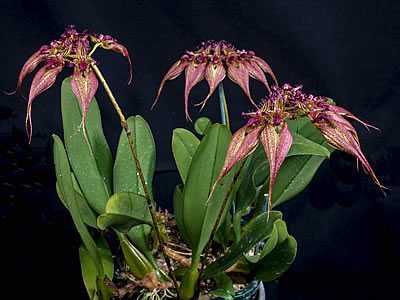The Bulbophyllum rothschildianum is a fascinating epiphytic orchid, primarily found in low to mid-altitude forests in southern Yunnan, China, Assam in northeastern India, and also in Burma. This species is known to be a rhizomatous orchid, possessing ovoid to flattened pseudobulbs, each supporting a single apical leaf. The leaves of this orchid are firm, fleshy, and exhibit a bright green color. Additionally, the Bulbophyllum rothschildianum tends to emit aerial roots out of the substrate, contributing to its curious and unique appearance.
Interestingly, the inflorescence of Bulbophyllum rothschildianum is basal and emerges from a long floral stalk, which can be either erect or decumbent. It is characterized as an umbel type, with few flowers displaying an inflated appearance, in cream yellow color, but extensively speckled with meat-red. The upper petals of this orchid are fringed, while the lower ones join to form a shape resembling a balloon, similar to a shoe with a tapered tip. Its labellum is short and of a striking red hue. The flowering of Bulbophyllum rothschildianum mainly occurs in spring or autumn, and its flowers are fragrant, although their scent may not be pleasing to everyone, being less unpleasant when compared to other plants of the same genus.

Without a doubt, the Bulbophyllum rothschildianum is an orchid that deserves a prominent place in any collection. This species can be grown in clay pots or baskets, opting for a hanging form, or even by staking the floral stems to keep them erect. The wild and exotic aspect of this orchid arouses great interest among enthusiasts. Additionally, it is often used in the production of hybrids, being crossed with other orchid species, where it commonly adds a touch of exoticism and its distinctive shapes.
For its ideal cultivation, the Bulbophyllum rothschildianum should be kept under partial shade or diffused light, in a fast-draining substrate, suitable for epiphytic orchids. Watering should be done regularly, and this species particularly appreciates the constant heat and humidity typical of the tropics. It is essential, especially in the south of the country where the climate is subtropical, to grow it in climate-controlled greenhouses. The plant prefers temperature ranges between 12 and 33 degrees Celsius (54 to 91 degrees Fahrenheit). It’s important to note that despite its needs for humidity and heat, it’s crucial that the orchid has access to good ventilation for efficient gas exchange.
Another fundamental aspect in the cultivation of Bulbophyllum rothschildianum is the biennial repotting, which is important for the renewal of the substrate, especially when it is composed of materials that decompose quickly. Watering should be frequent, keeping the substrate moist, especially during the summer. In winter, it is possible to allow the substrate to dry out a bit between waterings. Regular fertilization during the vegetative period and flowering with orchid-specific fertilizers is recommended, but in milder doses, considering the sensitivity of this plant. Fertilization should be suspended during winter.
This orchid can be propagated through the division of the clump, an effective and commonly used method. It is important to ensure that each division contains at least three healthy pseudobulbs with roots and a leading shoot. The ideal time to perform this division is just after the flowering period, when the plant is entering its active growth phase. After division, each new plant should be planted in its own pot, using a substrate appropriate for epiphytic orchids, and care like that applied to the mother plant should be followed.


